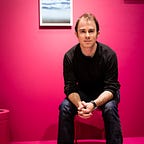The Hardware Fundraising Trap
This essay is the fourth in a series documenting lessons learned from my time at Electric Objects. Follow me on Medium to find out when the next essay is published.
In response to yesterday’s essay about belief and venture capital, Hunter Walk posed a great question that I thought would be useful to share with those following along.
Knowing this, would you have funded EO differently from the start? Would you have *not* done EO? Or would have just fundraised from venture differently, believing there were moments where raising a little more money on belief, would have gotten you to the milestones around profitability or raising more $$$?
The better path may not have been an option for me at the time, given where the company was, and where I was in my career, but if I were to start Electric Objects today, here’s how I’d think about fundraising and business design.
When I set out to raise my first round of capital, my goal was to raise just enough to fund us through our Kickstarter campaign, thinking that that validation was the next obvious milestone for the business. My fundraising target was $400k.
I spoke to a few investors who found the vision compelling, and pretty quickly found myself in the middle of a $1.5m round with top notch lead investors like RRE and First Round Capital. They, rightfully, knew that VCs discount Kickstarter success as an indication of product/market fit — the thinking being that early adopters on Kickstarter are not representative of a mainstream audience. They also knew that I couldn’t actually fulfill a Kickstarter campaign with just $400k. So they were right to guide me towards a larger round.
Even then, however, we underestimated the capital it would take to get from “Seed” to “Series A.” Quotation marks intended. Most VCs have in their heads an idea for a “Series A” company, and if you’re out of sync with that vision, you’re going to struggle to raise money.
Most hardware founders that I talk to today are thinking about their financing trajectory like this:
- $3m Seed: 2 years with a team of 10 ($2.5m), and getting a hardware product to market ($500k).
- $10m Series A: 2 years with a team of 20 ($5m), marketing to fund $10m of revenue ($3–4m), and working capital to finance inventory.
- By your Series B you’re either a) close to profitable or b) showing such amazing top line momentum that you can finance your growth with lots of eager VCs.
Note: This is not the only way to build a great hardware business. There are lots of examples of hardware companies that never raise a dime early on. See Makerbot and GoPro for two incredible early stage bootstrapping stories.
At Electric Objects, we raised a $1.5m “Seed” round (when we should’ve raised $3m), which means that by the time our “Series A” rolled around, we were only able to raise $5m (when we should’ve raised $10m). By the time our “Series B” rolled around, we looked like a “Series A” company, and couldn’t raise enough capital to keep going.
We had accomplished a lot with very little capital, but in my experience, and in conversations with other hardware founders, you don’t really get credit for being capital efficient. You get credit for top line momentum.
And just to be clear, let me reiterate a point from yesterday’s essay:
I won’t go so far as to say we couldn’t have made the company work with the capital we raised. A good way to measure the amount of capital raised is to count the number of mistakes you can afford. At Electric Objects it’s not so much that we didn’t raise enough money, we just made more mistakes than we had money to recover from.
So if I were to do it again, I wouldn’t just raise more money early on, I would spend it differently. I would be more sensitive to margins and fixed costs, more focused on fundamentals, and laser-focused on finding that engine of acquisition that turns product into profit into more product. More profit, less belief.
